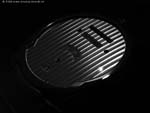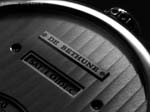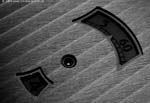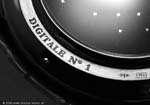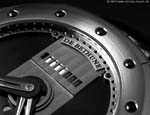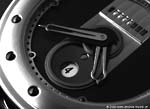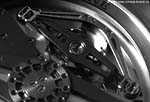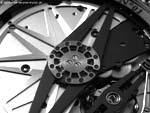The
X-Files
The Quest for a Mechanical Rapprochement of Quartz-Accuracy
An inside report of De Bethune SA, La Chaux l'Auberson
by Magnus Bosse, November 2006
Part
5
click on small images to view full-size ones!
5.
The current De Bethune Collection - Part
II
This remaining part of the De Bethune collection shall serve as an
indication as to where this brand is imagining itself in the market
- avantgarde
watchmaking
and designwork. The watches shown here are certainly much less than
the previous ones destined and palatable for the majority of the
watch aficionados, and even I myself have to admit that it sometime
took quite some effort to overcome initial resentiments. However,
it is always important to apporach novelties with an open mind. I
tried my best and here we are with some impressions of the
- Digitale
- GMT Automatic
- Maxichrono
Lean back, have fun and enjoy!
5.1 The
De Bethune Digitale (Jumping
Hour & Minute, Triple
Date, Spherical Moon; handwind):
This
culmulation - and simultaneously the antithesis?
- to the DBS and DBL watche series is the
Digitale. Its rather austere appearance comes
from the entire lack of any hand on the golden
face: On a finely applied sea of Geneva waves
three windows display, from the top down,
the date (weekday, date, month, in one row!)
and the minutes and hours. On top of this resides the screwed-on De Bethune Logo.
Depending on the angle of view, the effect
of the stripes is quite dramatic, and reveals
the savoir faire of decoration at De Bethune nicely.
Dial structure and displays accentuate the vertical axis of this watch, only
contrasted by three islands of rubies which serve to fis wheel axes: A symbol
for the triptychon of complications: Triple Date, Jumping hours and minutes,
and the signatory Moonphase. Moonphase?
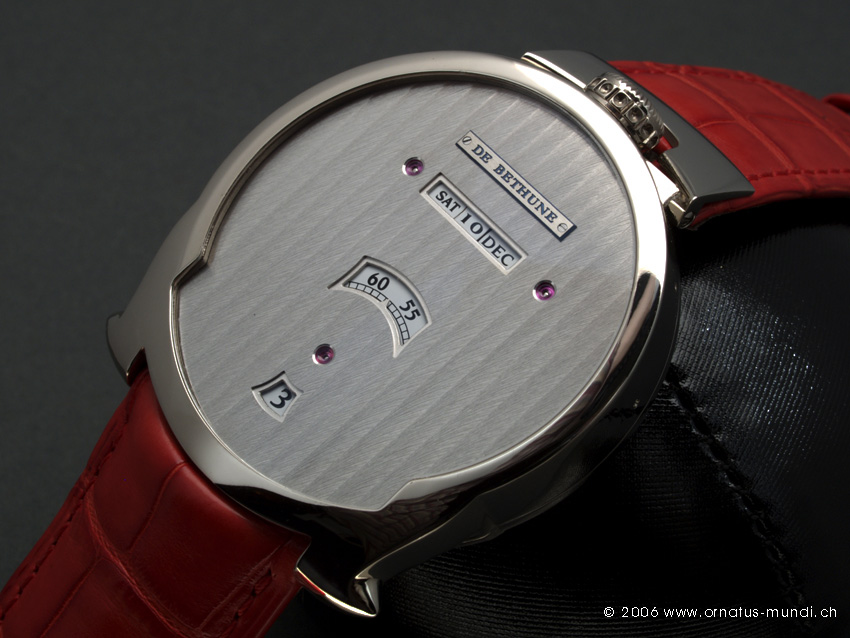
Other then that, the watch houses the Cal. 2014D movement with the IOS 3, enabling for 9 days of power reserve.
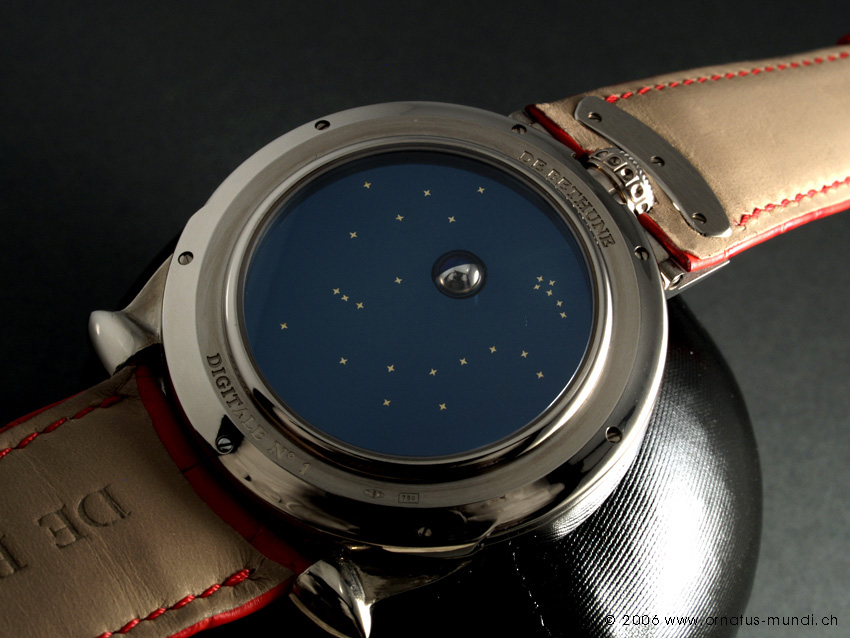
Why do I consider this watch at the same time the apogee and the contradiction of the DBS/DBL? Now, this watch is a small provocation: No dial in a common sense - yet the face draws all attention. Clearly showing its pedigree in the DBS - but yet, the window concept has no roots in those watches. An astronomic watch: our calendar is clearly derived from the course of the moon - but the moon, he driving force, has been removed from instant visibility to the back (is this now an emphasis or an attenuation, or irony?). It contradicts itself: a mechanical, analogue watch - yet all indications are digital. This watch has so many secrets and stories to tell, the I can only say that I raise my hat against the genius who devised this concept!
No torpedo lugs? No flat case? No heart-shaped movement? Well, still truely De Bethune: This watch is a sizeable departure from the existing aesthetic theme, but not from the fundamental concept of original movement in orginal cases. This new family, at De Bethune affectionately christened "Dream Watches", reveals another face of this vibrant company: the creation of entirely modernist watches which virtuously play with aesthetic elements, new materials and sometimes irritating interpretations of traditional concepts.
The GMT Automatic, also called DB20, comes with the first De Bethune in-house automatic movement which is not derived from a historical one. A vigilant observer of De Bethune instantly assumes that also this new engine is loaded with technical delicacies, and right he or she is. But I will as always start with the clothes of this watch. First you notice is the unusual hefty case with a diameter of 45mm with massive lugs, attached to the case by hexagon sockets. Longitudinal kerfs accentuate the vertical axis and add some visual airiness to the otherwise bold design. The massive bezel features two layers, a polished lower one and a brushed, massive upper one with beautifully heat-blued polished titanium markers for every hour. Strikingly, the bezel has an unusual porthole shape with emphasis on each uneven hour. What seems like a rather weird combination (of 30 pieces for the case alone!) actually works quite well:
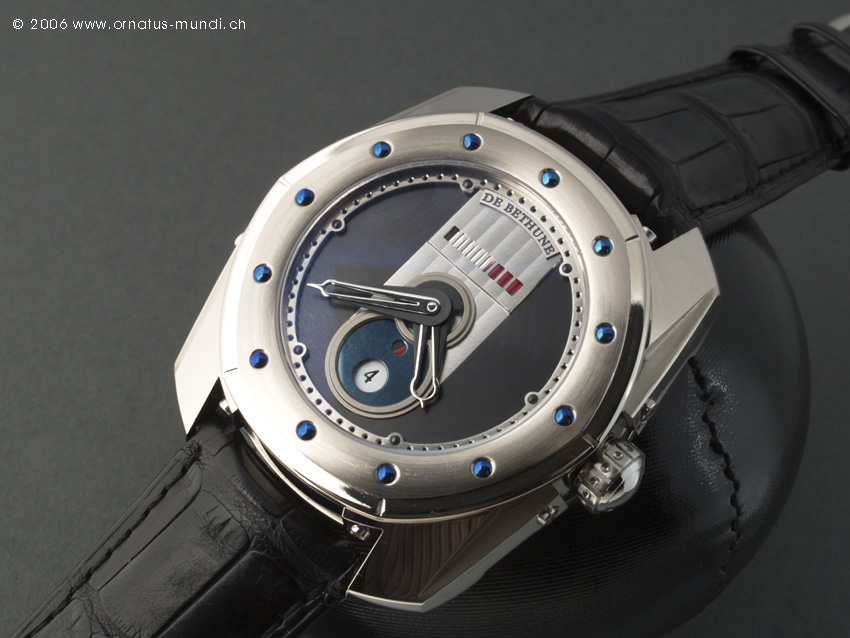
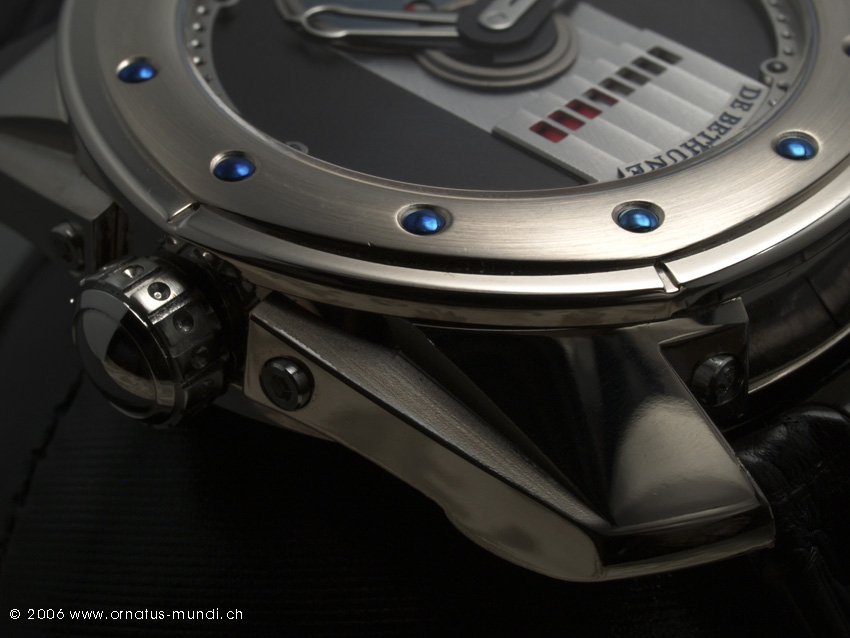
All indications originate from the central plate: From top, there is a horizontal power reserve (5 days!) gauge, then the minute and hours hands and below, set in a heat blued steel plate, the jumping second timezone with a day/night indicator. Surprisingly for a travel watch, there is no date.
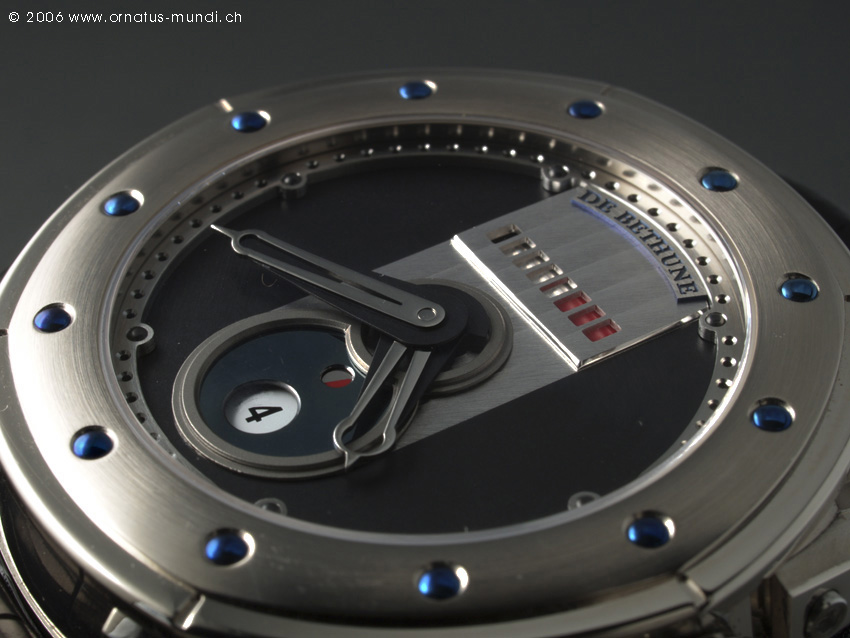
If you look closely, De Bethune also implemented another element from there: the shock-protection system. The rotor is mounted with the central trefoil-shaped plate with four "leaves", each carrying three rubies. These rubies press the rotor agains outer portion of the ball bearing (hidden), and thus provide for some protection against heavy shocks. The energy delivered by the rotor is fed into two mainspring barrels, which drive - in this case - an IOS 3 balance running at 28.800 bph. The entire movement is, quite a match to the concept!, of rather technical, but very elaborate and beautifully executed finish with highlighted "spokes" on the main plate:
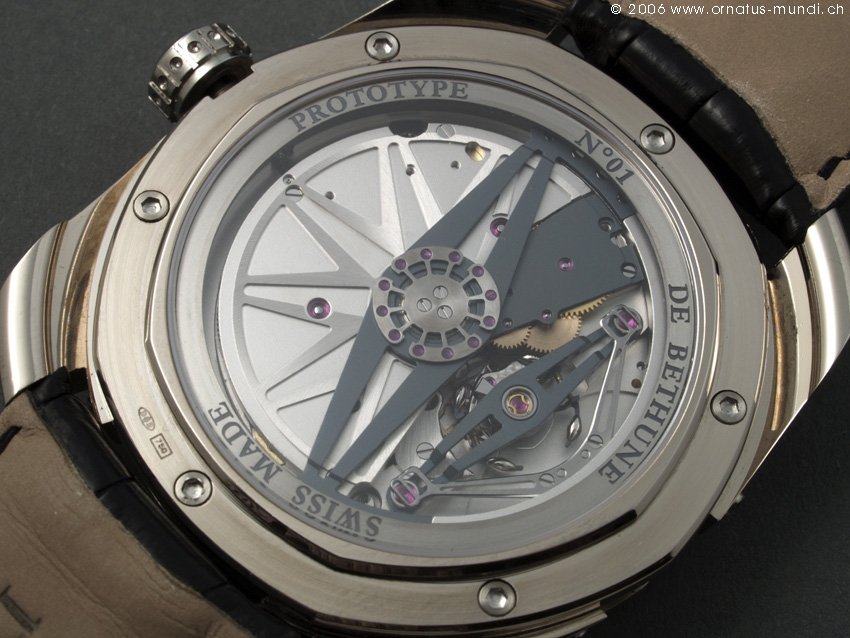
Finally, the most controversial watch: the Maxichrono, or De Bethune DB21! Clearly of similar breed than the GMT Automatic (45mm case as well with similar design), this impressive Chronograph is at the same time more traditional as it is avant-garde. Traditional, because it is equipped with a round dial and a monopusher mechanism operating on column wheel(s!). Avant-garde, not only because of the overall case design, but also because of unique fact that all hands are coaxially mounted in the center of the dial, and of course because of the movement: I mentioned already column wheels in plural, there are three of them, two visible on the back and one on the dial side, plus an eccentrically located vertical clutch.
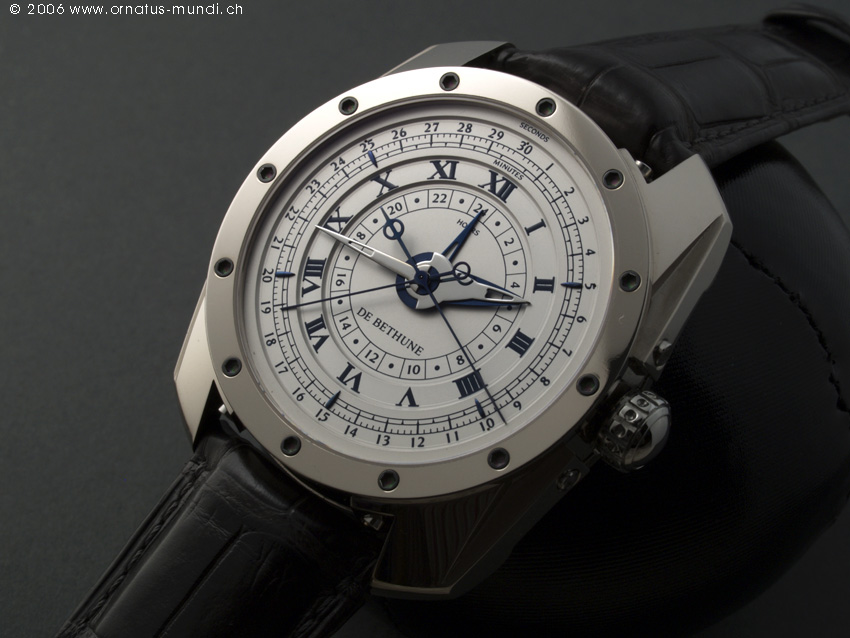
However, and this is my personal view, I find it a bit irritating to read a 30min (chronograph minute counter) and a 60min (time minute hand) indication concentrically located on one dial. This at least takes some efforts to get used to, and while the timing resolution surely is quite high, the instant readability of elapsed time suffers.
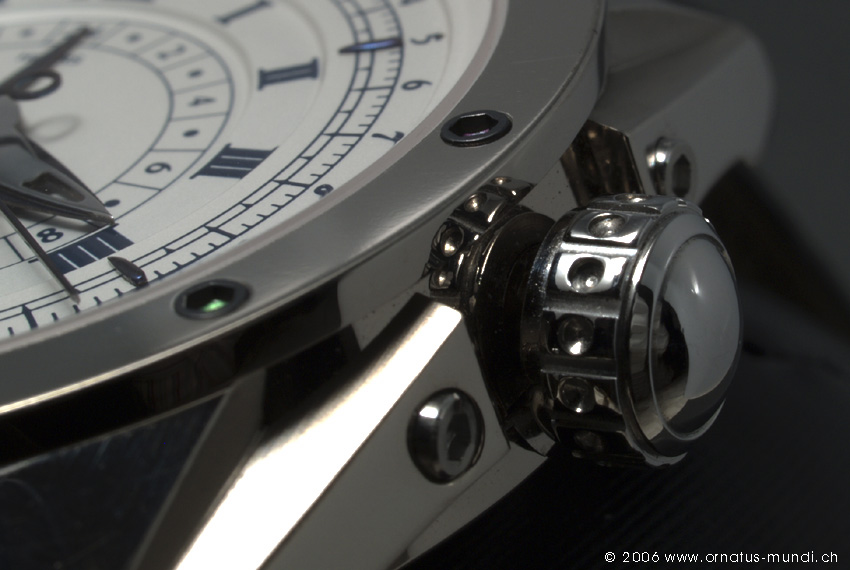
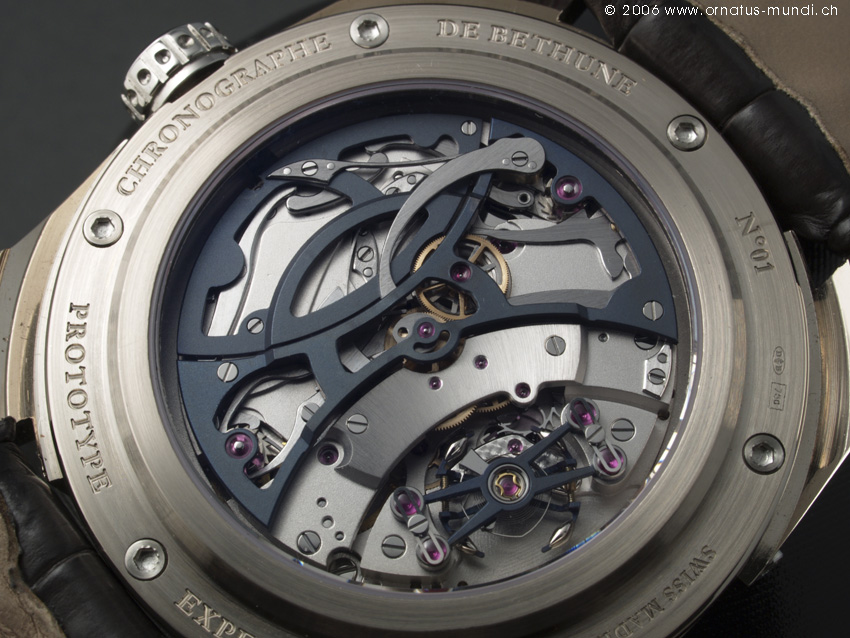
The
coaxial arrangement of the Chronograph works caused some spatial
limitations, thus De Bethune chose to rely on multiple column wheels
to faciliate the control of the stop works. The return-to-zero function
has to be controlled by two column wheels, whereas the start/stop
function is controlled by only one column wheel. Thus, three column
wheels are needed to control the Chronograph: 1 for start, stop and
reset of chrono second, 1 for minute counter reset and 1 for hour
counter reset located at the dial side.
The column wheels are relatively small in diameter
and perfectly covered by the titanium bridges. Remarkably, they are
supported on both sides in ruby settings (large image below and small
images, left). The
start/stop function is operated by a vertical clutch (the red gold
coloured two wheels in the center of the pic below (and small images,
middle), note also the elegantly swung reset lever!), a coupling
system that ensures smooth engagement and disengagement of the Chronograph
works with the going train. Finally, an IOS 3, is used, this time
with a comparatively short triple para-chute bridge on top.
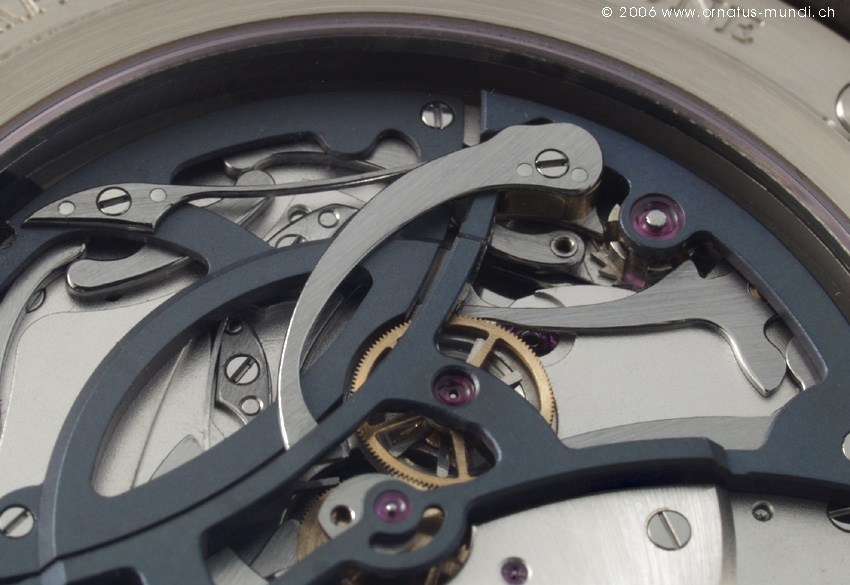
The
watch is an interesting technical solution for sure. The movement
is a watchmaking masterpiece, wonderfully executed with fine materials
in perfect craftsmanship. Modern and old techniques and materials
rarely mate that troublelessly and free of lackadaisical attitudes.
However, I find the technical concept a bit perplexing. The centrally
located Chronograph hands are a most welcome idea, but, as written
above, are a bit cumbersome with the 30sec/30min counter layout. This
is not intuitive nor consequent at all. Furthermore,
the use of three column wheels to control at least partly the same
function of different counters seems to me, albeit seemingly a
necessity because of the overall coaxial Chronograph indication (making
it necessary that its train somehow cramps around the central axis),
prone to inconsistencies and problems with coordination. Great
care has to be taken while assembling and adjusting the movement.
But this should not hide my great excitement about the
existence of this watch, so unusual and original, so fascinating
to look at from both sides, so clearly a non-derivative product that
I can only applaud De Bethune to having the guts to create this!
A
Final Verdict:
There are great watchmaking companies, there are the true manufactures,
there is the mass of everything, and there are the lone fighters
of independent watchmakers. De
Bethune is nothing of these, but still they are something like a
blend of all of them as well (I take out the mass here...!). What
is so amazing and noteworthy of this is that the result is not a
boring mix witout a face. Quite the opposite is true!
De Bethune is a small cell in the universe of watchmaking,
highly active and always ready to shake our minds with concepts not
exactly compatible with John Q. Public's taste. The very low production
volume leaves room for this, as no massive production capacities
and workforce have to kept busy (which means large production, which
causes more mainstream designs...). It is exactly this what takes
them apart from so many others, and what makes me sure that this
company is there to survive in its niche.
De Bethune managed to strike a successful balance between the interior
and the exterior, between the engine and the coachwork. With the
increasing technical departure from the commons, the case and dial
design follows suit. But neither technique nor aesthetics ever lose
completely track of what I would call "functional inspiration",
adding massively to the charm of this concept.
On the technical side, I have would say that from my layman perspective
the solutions offered by De Bethune seem to address crucial probelms
in mechanical watchmaking. just recall the IOS system, which not
only employs modern materials, but also unusual techniques in production.
They are elaborate and depend on significant expertise in construction,
adjustment and assembly.Take for example the UV glueing of the two
components of the balance spring. This is unheard of and on the first
view contradicting to the delicate nature of the balance spring.
I can not comment on the technical merit and long-term oerformance.
but at least De Bethune claims to have this system tested for a long
time and, importantly, also in different movements from outside manufacturers.
It would be great to see a ceteris paribus analysis to prove the
advantages of this system.
If you are a person with a wide interest
in a vast set of different or even opposing topics (be it digital
cameras and antique Gobelins, for example), you will never get tired
about this ever dramatical but never affected blend of modern and
traditional technology. This is why I think of De Bethune as the
watch for a 21st century Gentleman. An urban, polyglott gentleman
who inguinously oscillates between the antipodes of modern life without
ever having to rely on anything else than their own personality. Such
men would not drive a Bentley, but a Bristol!
-------------------------------------------------------------
Acknowledgements:
Thanks also to Suitbert Walter from ThePurists.com for an intensive discussion of the technical aspects and others for expert proof-reading. All mistakes are nontheless my responsibility.
The images are taken with a Nikon Coolpix 5400 (workshop photos) and an Olympus E-1 digital SLR with a 35mm Zuiko ZD Macro lens, a remote flash and a self-made perspex lighthouse.
Part 2 - Watchmaking at De Bethune today
Part 3 - De Bethune's bespoke movements and its unique "spider" balance assembly
Part 4 - The current De Bethune collection - Part I
Part 5 - The current De Bethune collection - Part II
Magnus Bosse © November 2006 Last update 04 January 2007
